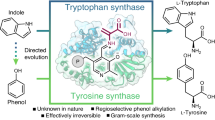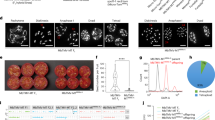Abstract
THE haploid sporidial stage of the anther smut fungus, Ustilago violacea, consists of yeast-like uninucleate cells of two mating types, a1 and a2. When complementary auxotrophs of opposite mating type are conjugated and plated on minimal medium (MM), several types of prototrophic colonies grow up, the most distinctive of which are the translucent colonies of diploids, heterozygous for mating type and formed by karyogamy. These appear with a frequency of about 3 per 104 conjugated cells1 and have been exploited for mitotic mapping in this species2. The other types of prototrophs seem to carry only one mating-type allele and form opaque colonies. These prototrophs form with a frequency of about 1 per 103 conjugated cells, and we show here that they arise from either conjugant after a number of chromosomes have been gained from the other conjugant. We also show that most of them are not conventional aneuploids, but that they have the extra chromosomes sequestered in such a way that they are lost or gained as an entity. The frequency of these segregants and their stability suggest that this process may play a hitherto unsuspected part in the origin of new physiological races in this species and perhaps also in other fungi.
This is a preview of subscription content, access via your institution
Access options
Subscribe to this journal
Receive 51 print issues and online access
$199.00 per year
only $3.90 per issue
Buy this article
- Purchase on Springer Link
- Instant access to full article PDF
Prices may be subject to local taxes which are calculated during checkout
Similar content being viewed by others
References
Day, A. W. & Jones, J. K. Genet. Res. 11, 63–81 (1968).
Day, A. W. & Jones, J. K. Genet. Res. 14, 195–221 (1969).
Day, A. W. Can. J. Bot. 50, 1337–1345 (1972).
Tinline, R. D. & MacNeill, B. H. A. Rev. Phytopath. 7, 147–170 (1969).
Day, P. R. Genetics of Host-Parasite Interaction (W. H. Freeman, San Francisco, 1974).
Fischer, G. W. & Holton, C. S. Biology and Control of the Smut Fungi (Ronald, New York, 1957).
Watson, I. A. & Luig, N. H. Proc. Linn. Soc. N.S.W. 83, 190–195 (1958).
Bartos, P., Fleischmann, G., Samborski, D. J. & Shipton, W. A. Can. J. Bot. 47, 1383–1387 (1969).
Ellingboe, A. H. Proc. natn. Acad. Sci. U.S.A. 49, 286 (1963).
Flor, H. A. Rev. Phytopath. 9, 275–296 (1971).
Author information
Authors and Affiliations
Rights and permissions
About this article
Cite this article
DAY, A. Chromosome transfer in dikaryons of a smut fungus. Nature 273, 753–755 (1978). https://doi.org/10.1038/273753a0
Received:
Accepted:
Issue Date:
DOI: https://doi.org/10.1038/273753a0
Comments
By submitting a comment you agree to abide by our Terms and Community Guidelines. If you find something abusive or that does not comply with our terms or guidelines please flag it as inappropriate.



